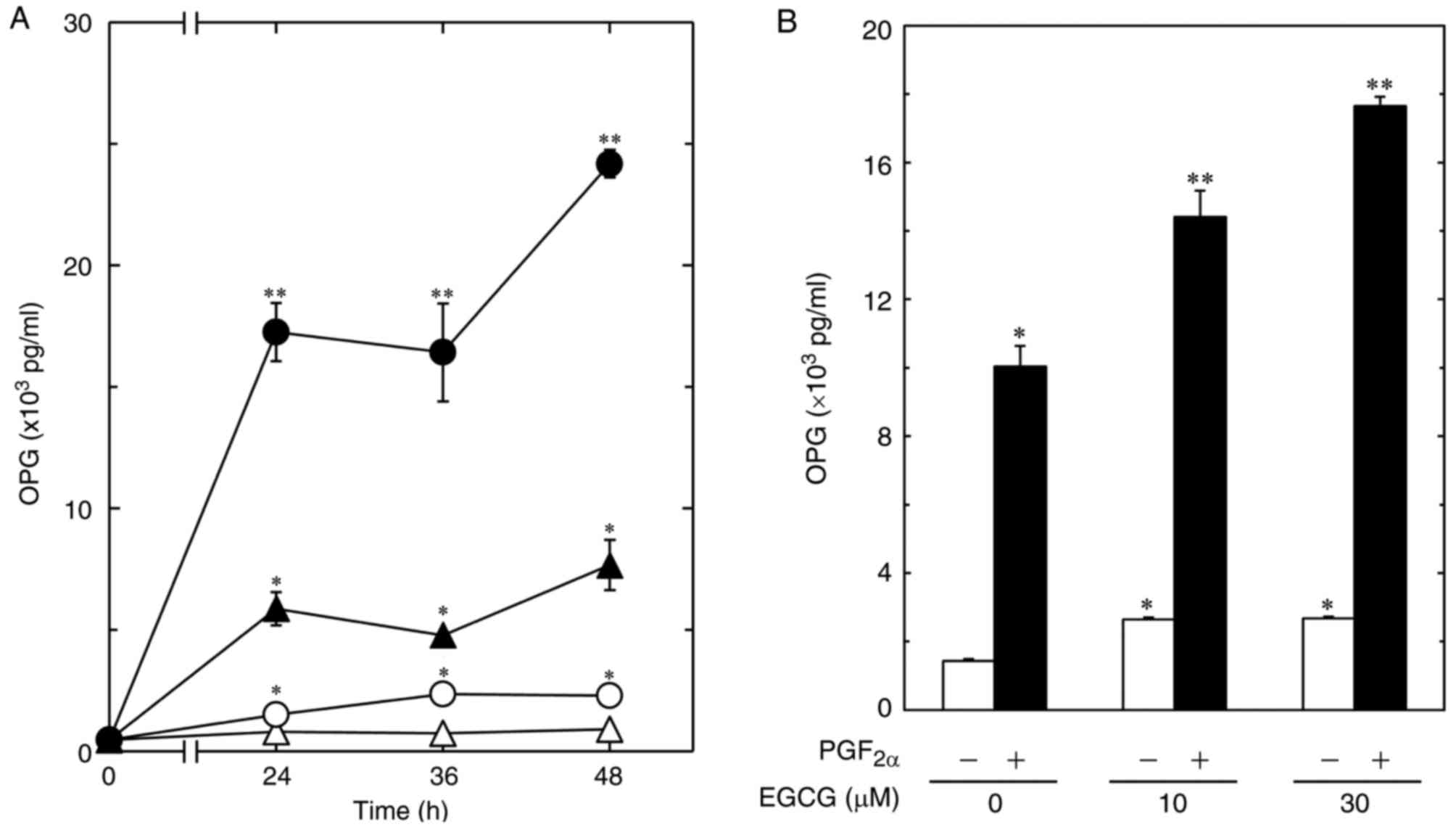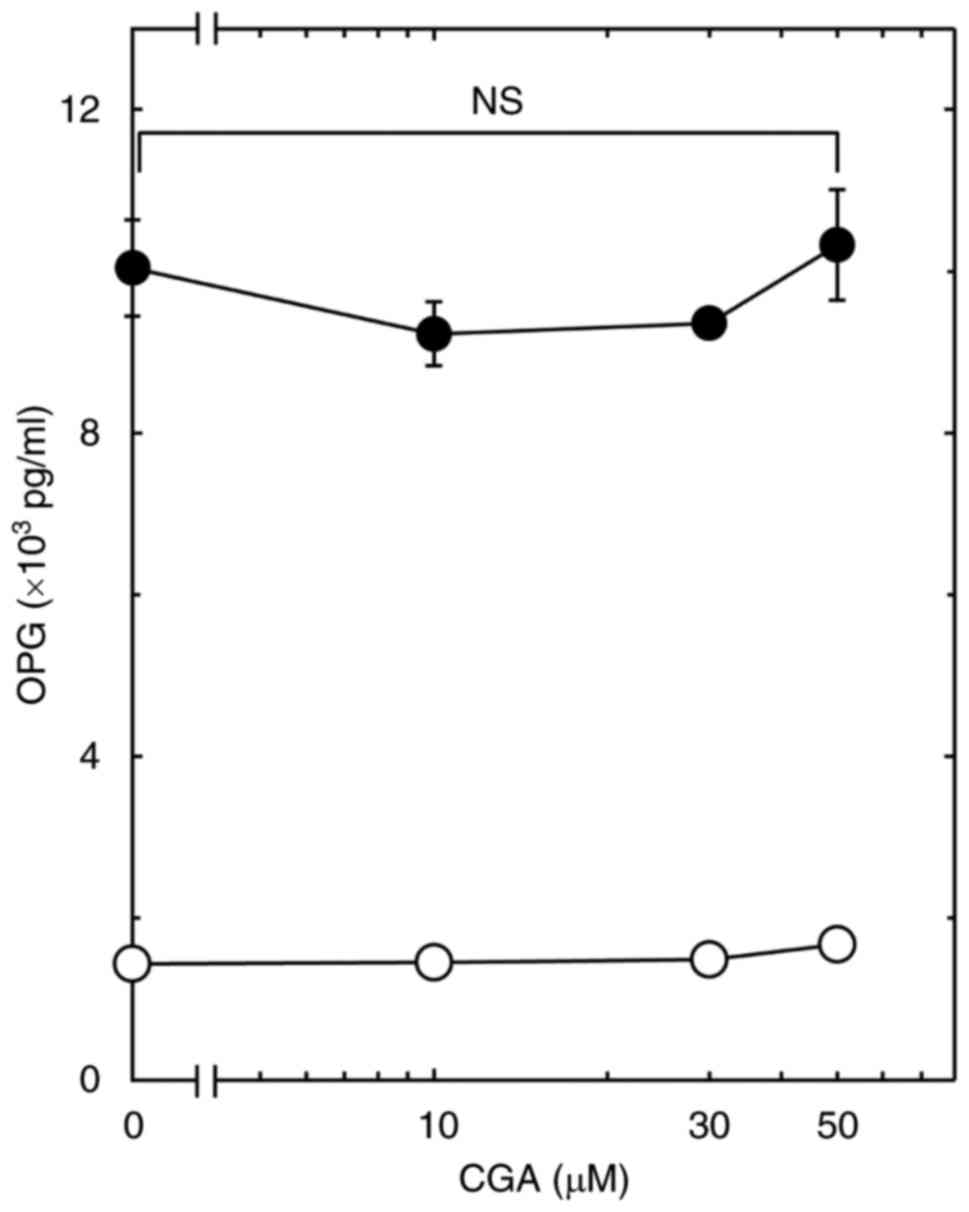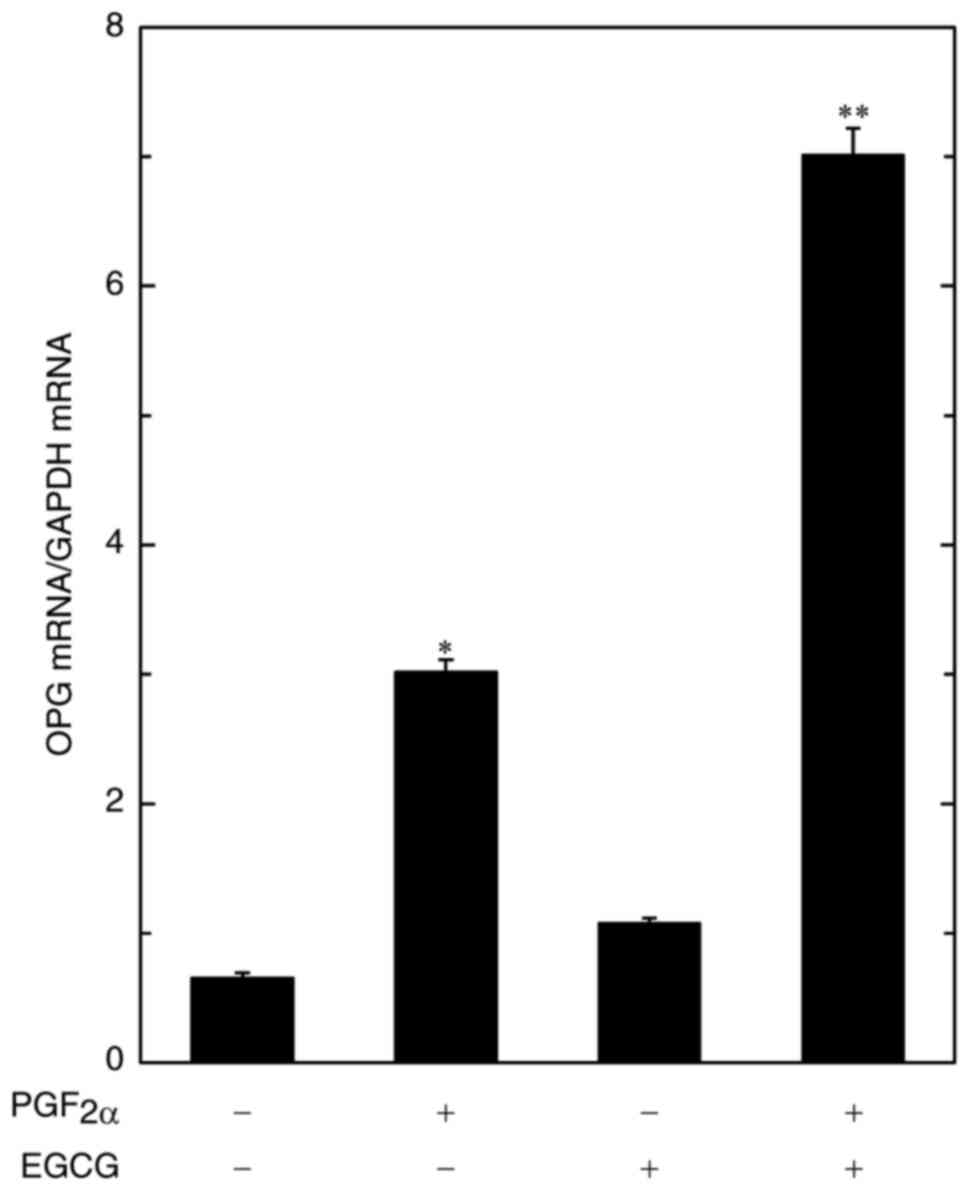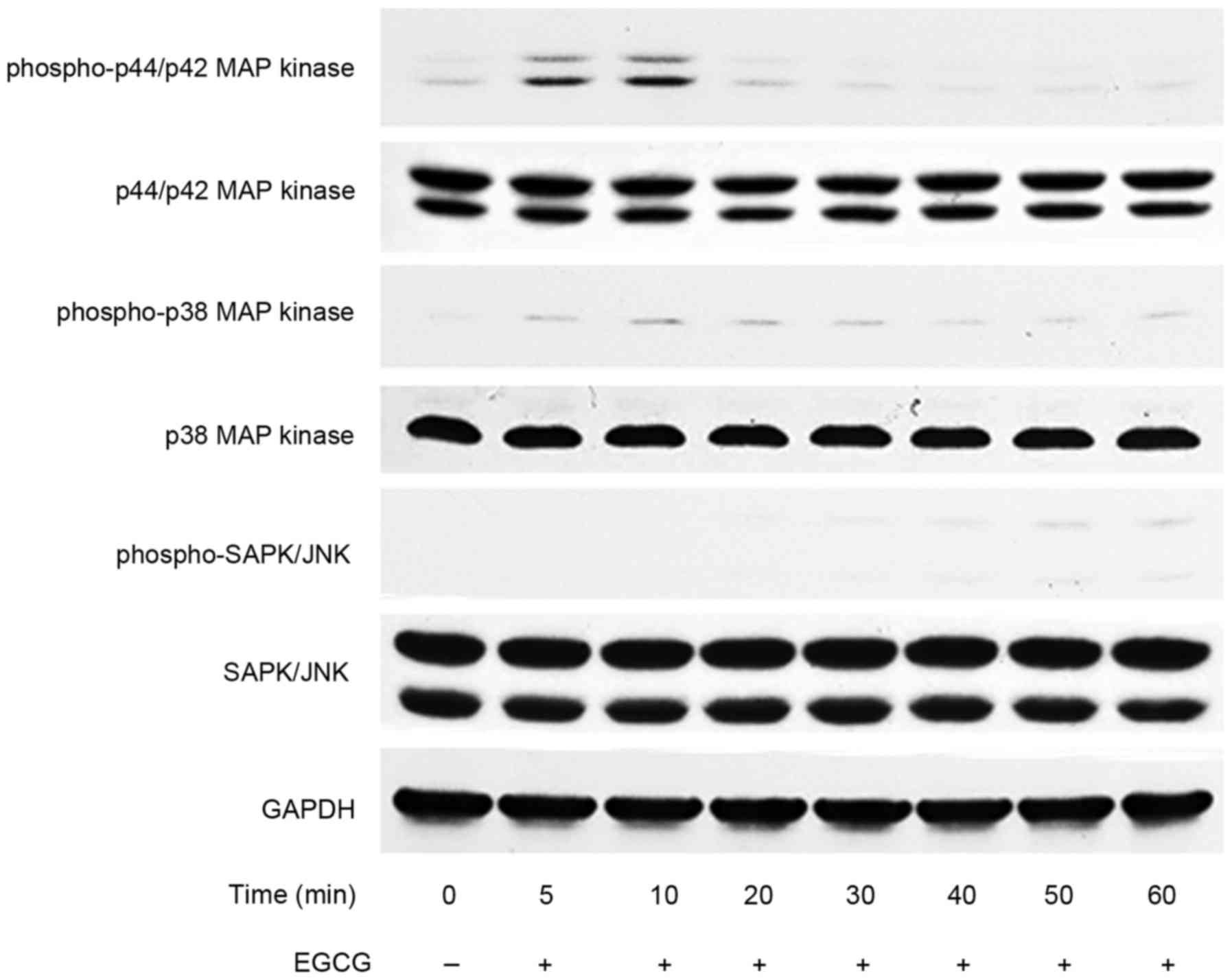Amplification by (‑)‑epigallocatechin gallate of prostaglandin F2α‑stimulated synthesis of osteoprotegerin in osteoblasts
- Authors:
- Published online on: August 24, 2017 https://doi.org/10.3892/mmr.2017.7354
- Pages: 6376-6381
Abstract
Introduction
Green tea and coffee are traditionally consumed as dietary beverages all over the world. It is generally recognized that polyphenolic compounds in green tea have potentially beneficial effects on human health including anti-inflammation, anti-oxidation and prevention of tumor development (1,2). In addition, polyphenolic compounds in coffee are proposed to potentiate human health benefits such as prevention of type 2 diabetes mellitus and Parkinson's disease (3). A major flavonoid of green tea is (−)-epigallocatechin gallate (EGCG), which is considered as one of the most active polyphenolic molecules relating to the health promoting properties of this beverage (4). On the other hand, chlorogenic acid (CGA) is a main phenolic compound in coffee (5). Regarding the beneficial properties of green tea and coffee for bone disorders, accumulating evidence indicates that consumption of green tea prevents both age-related bone loss and fracture in elderly people (6), and that coffee consumption reduces the risk of osteoporosis and osteoporotic fracture (3). However, the details underlying the beneficial effects of green tea and coffee on bone remain unclear.
Bone metabolism is mainly regulated by two types of functional cells, osteoblasts and osteoclasts (7). The former cells are responsible for bone formation, and the latter cells are for bone resorption. In the adult skeletal system, bone mass is continuously maintained by resorption of old bone and subsequent formation of new bone, so called bone remodeling. Disorder of this important process is considered to cause metabolic bone diseases, including osteoporosis and fracture healing distress. It is currently recognized that various humoral factors including cytokines, hormones, growth factors and prostaglandins (PGs) play important roles as bone remodeling mediators (8). As for the EGCG-effects on bone metabolism, it has been shown that EGCG attenuates bone resorption through the inhibition of osteoclast formation, resulting in suppression of osteoclastogenesis (5). In osteoblasts, EGCG reportedly increases alkaline phosphatase activity followed by increment of osteoblastic bone formation (5). On the other hand, it has been reported that CGA suppresses osteoclast-mediated bone resorption by downregulation of receptor activator of nuclear factor-κB (RANK) ligand-mediating effects (9). In vivo studies in rat model, CGA increases mineralization in the tibia and improve mechanical properties of the femoral diaphysis (10). We have previously reported that EGCG suppresses the interleukin-6 (IL-6) synthesis stimulated by platelet-derived growth factor-BB, basic fibroblast growth factor or endothelin-1 in osteoblast-like MC3T3-E1 cells (11–13). Additionally, we recently demonstrated that EGCG and CGA enhance the tumor necrosis factor-α (TNF-α)-stimulated IL-6 synthesis in these cells (14). However, the exact mechanism behind the effects of EGCG and CGA on bone remodeling has not yet been elucidated.
Osteoprotegerin (OPG) is a cytokine which has an inhibitory effect on osteoclast functions. OPG is classified into a member of the TNF receptor family along with RANK (15). OPG, which is produced in osteoblasts and secreted, binds to RANK ligand (RANKL) as a decoy receptor and prevents RANKL from binding to RANK, resulting in the suppression of bone resorption through the reduction of both osteoclastgenesis and osteoclast activity (16). OPG-deficient mice and RANKL-overexpressing transgenic mice reportedly suffer from severe osteoporosis (17,18). Therefore, it is generally recognized that RANK/RANKL/OPG axis is a major regulatory system for bone remodeling (19). On the other hand, PGs are lipid mediators with various functions and play crucial roles in the pathophysiological responses of skeletal tissue (20). Among them, prostaglandin F2α (PGF2α) is a potent stimulator of bone resorption and promotes osteoclast formation (20). In addition, accumulating evidence indicates that PGF2α also takes part in the process of bone formation (21). We have previously shown that PGF2α stimulates the synthesis of OPG through the activation of p44/p42 mitogen-activated protein (MAP) kinase, p38 MAP kinase and stress activated protein kinase/c-Jun N-terminal kinase (SAPK/JNK) in osteoblast-like MC3T3-E1 cell (22).
In the present study, we investigated the effects of EGCG or CGA on the PGF2α-stimulated OPG synthesis in osteoblast-like MC3T3-E1 cells. We herein show that EGCG but not CGA upregulates the PGF2α-stimulated OPG synthesis in osteoblasts.
Materials and methods
Materials
EGCG, CGA and PGF2α were purchased from Sigma-Aldrich (St. Louis, MO, USA). A mouse OPG enzyme-linked immunosorbent assay (ELISA) kit was obtained from R&D Systems, Inc. (Minneapolis, MN, USA). Phospho-specific p44/p42 MAP kinase antibodies, p44/p42 MAP kinase antibodies, phospho-specific p38 MAP kinase antibodies, p38 MAP kinase antibodies, phospho-specific SAPK/JNK antibodies and SAPK/JNK antibodies were purchased from Cell Signaling Technology, Inc. (Danvers, MA, USA). Glyceraldehyde-3-phosphate dehydrogenase (GAPDH) antibodies were obtained from Santa Cruz Biotechnology, Inc. (Santa Cruz, CA, USA). The enhanced chemiluminescence (ECL) Western Blotting Detection system was obtained from GE Healthcare Life Sciences (Little Chalfont, UK). Other materials and chemicals were obtained from commercial sources. EGCG was dissolved in dimethyl sulfoxide. CGA and PGF2α were dissolved in ethanol. The maximum concentration of dimethyl sulfoxide or ethanol was 0.1%, which did not affect either the assay for OPG or western blot analysis.
Cell culture
Cloned osteoblast-like MC3T3-E1 cells that have been derived from newborn mouse calvaria (23) were maintained as previously described (24). Briefly, the cells were cultured in α-minimum essential medium (α-MEM) containing 10% fetal bovine serum (FBS) at 37°C in a humidified atmosphere of 5% CO2/95% air. The cells were seeded into 35-mm diameter dishes (5×104 cells/dish) or 90-mm diameter dishes (2×105 cells/dish) in α-MEM containing 10% FBS. After 5 days, the medium was exchanged for α-MEM containing 0.3% FBS. The cells were used for experiments after 48 h.
Assay for OPG
The cultured cells were pretreated with various doses of EGCG or CGA for 60 min, and then stimulated by 10 µM of PGF2α or vehicle in 1 ml of α-MEM containing 0.3% FBS for the indicated periods. The conditioned medium was collected at the end of incubation, and the OPG concentration was then measured using a mouse OPG ELISA kit according to the manufacturer's protocol.
Real-time (RT)-PCR
The cultured cells were pretreated with 10 µM of EGCG or vehicle for 60 min, and then stimulated by 10 µM of PGF2α or vehicle in α-MEM containing 0.3% FBS for 6 h. Total RNA was isolated and transcribed into complementary DNA using TRIzol reagent (Invitrogen; Thermo Fisher Scientific, Inc., Carlsbad, CA, USA) and OmniScript Reverse Transcriptase kit (Qiagen, Inc., Valencia, CA, USA), respectively. RT-PCR was performed using a LightCycler system (version 3.5; Roche Diagnostics, Basel, Switzerland) in capillaries and FastStart DNA Master SYBR Green I provided with the kit (Roche Diagnostics). Sense and antisense primers for mouse OPG mRNA were purchased from Takara Bio, Inc. (primer set ID: MA026526; Otsu, Japan), while mouse GAPDH mRNA primers were synthesized based on the report of Simpson et al (25). The amplified products were determined using a melting curve analysis. The OPG mRNA levels were normalized to those of GAPDH mRNA.
Western blot analysis
The cultured cells were pretreated with various doses of EGCG for the indicated periods, and then stimulated by 10 µM of PGF2α or vehicle in α-MEM containing 0.3% FBS for the indicated periods. The cells were washed twice with phosphate-buffered saline and then lysed, homogenized and sonicated in a lysis buffer containing 62.5 mM Tris/HCl (pH 6.8), 2% sodium dodecyl sulfate (SDS), 50 mM dithiothreitol and 10% glycerol. SDS-polyacrylamide gel electrophoresis (PAGE) was performed using the method of Laemmli (26) in 10% polyacrylamide gels. The proteins were fractionated and transferred onto an Immun-Blot polyvinylidene difluoride (PVDF) membranes (Bio-Rad Laboratories, Inc., Hercules, CA, USA). The membranes were blocked with 5% fat-free dry milk in Tris-buffered saline-Tween (TBS-T; 20 mM Tris-HCl, pH 7.6, 137 mM NaCl, 0.1% Tween-20) for 2 h prior to incubation with primary antibodies. A Western blot analysis was performed as described previously (27) using antibodies against phospho-specific p44/p42 MAP kinase, p44/p42 MAP kinase, phospho-specific p38 MAP kinase, p38 MAP kinase, phospho-specific SAPK/JNK, SAPK/JNK or GAPDH as primary antibodies at a dilution of 1:1,000 in 5% milk in TBS-T overnight at 4°C. Goat anti-rabbit IgG horseradish peroxidase-labeled antibodies (KPL, Inc., Gaithersburg, MD, USA) were used as secondary antibodies at a dilution of 1:1,000 in 5% milk in TBS-T for 1 h at room temperature. The peroxidase activity on the PVDF sheet was visualized on X-ray film by means of the ECL Western Blotting Detection system.
Determinations of the absorbance for ELISA and the densitometric analysis for western blotting
The absorbance of the ELISA samples was measured at 450 nm with the EL 340 Bio Kinetic Reader (Bio-Tek Instruments, Inc., Winooski, VT, USA). Densitometric analysis was performed using a scanner and image analysis software package (ImageJ version 1.48; National Institutes of Health, Bethesda, MD, USA). The phosphorylated protein levels were calculated as follows: the background-subtracted signal intensity of each phosphorylation signal was respectively normalized to the total protein signal and plotted as the fold increase in comparison with that of the control cells without treatment or stimulation.
Statistical analysis
The data were analyzed by an ANOVA followed by Bonferroni method for multiple comparisons between pairs, and a p-value <0.05 was considered to indicate statistically significant difference. All data are presented as the mean ± standard error of the mean (SEM) of triplicate determinations from three independent cell preparations.
Results
Effects of EGCG or CGA on the PGF2α-stimulated OPG release in MC3T3-E1 cells
In our previous study (22), we have shown that PGF2α stimulates OPG synthesis in osteoblast-like MC3T3-E1 cells. Therefore, we first examined the effect of EGCG on the PGF2α-stimulated OPG release in MC3T3-E1 cells. EGCG significantly enhanced the PGF2α-stimulated OPG release time-dependently up to 48 h (Fig. 1A). The PGF2α-stimulated OPG release was significantly amplified by EGCG in a dose-dependent manner in the range between 10 and 30 µM. The maximum effect of EGCG on the release of OPG was observed at 30 µM, which caused an approximate 75% increase in the PGF2α-effect (Fig. 1B). On the contrary, CGA had little effect on the PGF2α-stimulated OPG release up to 50 µM (Fig. 2).
Effect of EGCG on the PGF2α-induced expression levels of OPG mRNA in MC3T3-E1 cells
In order to investigate whether the amplification by EGCG of the PGF2α-stimulated OPG release is mediated via transcriptional events in osteoblast-like MC3T3-E1 cells, we examined the effect of EGCG on the PGF2α-induced expression levels of OPG mRNA. EGCG at 10 µM significantly strengthened the PGF2α-induced OPG mRNA expression (Fig. 3).
Effects of EGCG on the PGF2α-stimulated phosphorylation of p44/p42 MAP kinase, p38 MAP kinase and SAPK/JNK in MC3T3-E1 cells
As for the intracellular signaling of PGF2α in OPG synthesis, we have recently demonstrated that p44/p42 MAP kinase, p38 MAP kinase and SAPK/JNK act as positive regulators in osteoblast-like MC3T3-E1 cells (22). Therefore, we next examined the effects of EGCG on the PGF2α-stimulated phosphorylation of p44/p42 MAP kinase, p38 MAP kinase and SAPK/JNK in these cells. However, EGCG failed to strengthen the PGF2α-induced phosphorylation of p44/p42 MAP kinase (Fig. 4A), p38 MAP kinase (Fig. 4B) or SAPK/JNK (Fig. 4C) over the range 10 to 30 µM. EGCG by itself markedly induced the phosphorylation of p44/p42 MAP kinase up to 10 min, and the status decreased thereafter, whereas EGCG hardly affected the phosphorylation status of p38 MAP kinase or SAPK/JNK within 60 min (Fig. 5).
Discussion
In the present study, we demonstrated that EGCG, most abundant catechin in green tea, significantly enhanced the PGF2α-stimulated OPG release in osteoblast-like MC3T3-E1 cells. In addition, we showed that EGCG increased the OPG mRNA expression levels induced by PGF2α. Based on these findings, it is most likely that the amplification by EGCG of the PGF2α-stimulated OPG release is mediated through a transcriptional event. To the best of our knowledge, this is probably the first report demonstrating the amplification of PGF2α-stimulated OPG synthesis by EGCG in osteoblast lineage. By contrast, CGA, which is contained abundantly in coffee, did not affect the PGF2α-induced OPG release in MC3T3-E1 cells. We have previously shown that CGA as well as EGCG enhances the TNF-α-stimulated IL-6 synthesis in these cells (14). Thus, it is likely that the effects of CGA on the IL-6 synthesis in osteoblasts would be different from EGCG in each stimulator or the responsive output.
In addition, we next investigated the intracellular signaling mechanisms underlying the effect of EGCG on the PGF2α-stimulated OPG synthesis in osteoblast-like MC3T3-E1 cells. It is generally established that the MAP kinase superfamily plays a pivotal role in a variety of cellular functions including proliferation, differentiation and survival (28). Three major MAP kinases including p44/p42 MAP kinase, p38 MAP kinase and SAPK/JNK, are generally recognized as central elements used by mammalian cells to transducer diverse messages (29). We have previously shown that PGF2α stimulates OPG synthesis via activation of p44/p42 MAP kinase, p38 MAP kinase and SAPK/JNK in osteoblast-like MC3T3-E1 cells (22). However, we found that EGCG hardly affected the PGF2α-induced phosphorylation of p44/p42 MAP kinase, p38 MAP kinase or SAPK/JNK in these cells. It is firmly established that MAP kinases are activated through the phosphorylation of threonine and tyrosine residues induced by the responsible dual specificity kinase, also known as MAP kinase kinase (30,31). Thus, it seems unlikely that the modulations of these MAP kinases activities are involved in the enhancement by EGCG of the PGF2α-stimulated OPG synthesis in osteoblast-like MC3T3-E1 cells. Regarding IL-6 synthesis, it is likely that EGCG might act at a point downstream of the MAP kinases or another target, directing the amplification of IL-6 synthesis. Indeed, we found that EGCG by itself markedly induced the phosphorylation of p44/p42 MAP kinase up to 10 min, and the status decreased thereafter, whereas EGCG hardly affected the phosphorylation status of p38 MAP kinase or SAPK/JNK within 60 min. It seems likely that EGCG affects the cell function of osteoblast-like MC3T3-E1 cells through the p44/p42 MAP kinase-mediating signaling. In addition, in order to investigate the PGF2α-effects on OPG synthesis in EGCG-affected osteoblasts compared with those in naive osteoblasts, osteoblast-like MC3T3-E1 cells were pretreated with EGCG for 60 min before PGF2α stimulation. Further investigations are necessary to elucidate the exact mechanism of EGCG in osteoblasts. Taking our findings into account as a whole, it is most likely that not CGA but EGCG enhances the PGF2α-stimulated OPG synthesis in osteoblast-like MC3T3-E1 cells, and that the amplifying effect of EGCG on the IL-6 synthesis is independent from the activation of p44/p42 MAP kinase, p38 MAP kinase or SAPK/JNK.
EGCG is a natural polyphenol abundantly found in green tea, and possesses numerous favorable effects on the health of human being through the actions of anti-oxidation (6). Accumulating evidence indicate that green tea consumption prevents both age-related bone loss and fracture in elderly people (6). It is well known that PGF2α has multiple effects on bone metabolism, and that PGF2α acts as a mediator of bone remodeling, resulting in the regulation of bone turnover (21). Osteoblast-producing OPG functions as a decoy receptor of RANKL, and blocks RANKL-RANK interaction which is critical for the osteoclastgenesis and the activation of osteoclasts (16,32). Based on our present findings demonstrating the upregulation by EGCG of OPG synthesis induced by PGF2α in osteoblasts, it is possible that EGCG directs the bone metabolism toward the increase of formation but the suppression of resorption. Therefore, the effect of EGCG showing here might provide a novel potential aspect for the favorable actions of EGCG-containing beverages in bone health for the elderly peoples. Further investigations would be needed to clarify the detailed mechanism of EGCG underlying the OPG synthesis in osteoblasts.
In conclusion, our results strongly suggest that EGCG but not CGA enhances the PGF2α-stimulated OPG synthesis in osteoblasts.
Acknowledgements
We are very grateful to Yumiko Kurokawa for her skillful technical assistance. This investigation was supported in part by a Grant-in-Aid for Scientific Research (26462289, 15K10487) from the Ministry of Education, a Grant-in-Aid for Scientific Research (H25-Aging-General-004) from the Ministry of Health, Labour and Welfare, and the Research Funding for Longevity Sciences (25–4, 26–12) from National Center for Geriatrics and Gerontology (NCGG), Japan.
References
|
Thielecke F and Boschmann M: The potential role of green tea catechins in the prevention of the metabolic syndrome-a review. Phytochemistry. 70:11–24. 2009. View Article : Google Scholar : PubMed/NCBI | |
|
Shimizu M, Adachi S, Masuda M, Kozawa O and Moriwaki H: Cancer chemoprevention with green tea catechins by targeting receptor tyrosine kinases. Mol Nutr Food Res. 55:832–843. 2011. View Article : Google Scholar : PubMed/NCBI | |
|
Higdon JV and Frei B: Coffee and health: A review of recent human research. Crit Rev Food Sci Nutr. 46:101–123. 2006. View Article : Google Scholar : PubMed/NCBI | |
|
Harborne JB and Williams CA: Advances in flavonoid research since 1992. Phytochemistry. 55:481–504. 2000. View Article : Google Scholar : PubMed/NCBI | |
|
George SE, Ramalakshmi K and Rao LJ Mohan: A perception on health benefits of coffee. Crit Rev Food Sci Nutr. 48:464–486. 2008. View Article : Google Scholar : PubMed/NCBI | |
|
Shen CL, Yeh JK, Cao JJ and Wang JS: Green tea and bone metabolism. Nutr Res. 29:437–456. 2009. View Article : Google Scholar : PubMed/NCBI | |
|
Karsenty G and Oury F: Biology without walls: The novel endocrinology of bone. Annu Rev Physiol. 74:87–105. 2012. View Article : Google Scholar : PubMed/NCBI | |
|
Parfitt AM: Targeted and nontargeted bone remodeling: Relationship to basic multicellular unit origination and progression. Bone. 30:5–7. 2002. View Article : Google Scholar : PubMed/NCBI | |
|
Kwak SC, Lee C, Kim JY, Oh HM, So HS, Lee MS, Rho MC and Oh J: Chlorogenic acid inhibits osteoclast differentiation and bone resorption by down-regulation of receptor activator of nuclear factor kappa-B ligand-induced nuclear factor of activated T cells c1 expression. Biol Pharm Bull. 36:1779–1786. 2013. View Article : Google Scholar : PubMed/NCBI | |
|
Folwarczna J, Pytlik M, Zych M, Cegiela U, Nowinska B, Kaczmarczyk-Sedlak L, Sliwinski L, Trzeciak H and Trzeciak HI: Effects of caffeic and chlorogenic acids on the rat skeletal system. Eur Rev Med Pharmacol Sci. 19:682–693. 2015.PubMed/NCBI | |
|
Takai S, Matsushima-Nishiwaki R, Adachi S, Natsume H, Minamitani C, Mizutani J, Otsuka T, Tokuda H and Kozawa O: (−)-Epigallocatechin gallate reduces platelet-derived growth factor-BB-stimulated interleukin-6 synthesis in osteoblasts: Suppression of SAPK/JNK. Mediators Inflamm. 2008:2918082008. View Article : Google Scholar : PubMed/NCBI | |
|
Tokuda H, Takai S, Hanai Y, Matsushima-Nishiwaki R, Yamauchi J, Harada A, Hosoi T, Ohta T and Kozawa O: (−)-Epigallocatechin gallate inhibits basic fibroblast growth factor-stimulated interleukin-6 synthesis in osteoblasts. Horm Metab Res. 40:674–678. 2008. View Article : Google Scholar : PubMed/NCBI | |
|
Tokuda H, Takai S, Hanai Y, Matsushima-Nishiwaki R, Hosoi T, Harada A, Ohta T and Kozawa O: (−)-Epigallocatechin gallate suppresses endothelin-1-induced interleukin-6 synthesis in osteoblasts: inhibition of p44/p42 MAP kinase activation. FEBS Lett. 581:1311–1316. 2007. View Article : Google Scholar : PubMed/NCBI | |
|
Yamamoto N, Tokuda H, Kuroyanagi G, Kainuma S, Ohguchi R, Fujita K, Matsushima-Nishiwaki R, Kozawa O and Otsuka T: Amplification by (−)-epigallocatechin gallate and chlorogenic acid of TNF-α-stimulated interleukin-6 synthesis in osteoblasts. Int J Mol Med. 36:1707–1712. 2015. View Article : Google Scholar : PubMed/NCBI | |
|
Kostenuik PJ and Shalhoub V: Osteoprotegerin: A physiological and pharmacological inhibitor of bone resorption. Curr Pharm Des. 7:613–635. 2001. View Article : Google Scholar : PubMed/NCBI | |
|
Simonet WS, Lacey DL, Dunstan CR, Kelley M, Chang MS, Lüthy R, Nguyen HQ, Wooden S, Bennett L, Boone T, et al: Osteoprotegerin: A novel secreted protein involved in the regulation of bone density. Cell. 89:309–319. 1997. View Article : Google Scholar : PubMed/NCBI | |
|
Mizuno A, Amizuka N, Irie K, Murakami A, Fujise N, Kanno T, Sato Y, Nakagawa N, Yasuda H, Mochizuki S, et al: Severe osteoporosis in mice lacking osteoclastogenesis inhibitory factor/osteoprotegerin. Biochem Biophys Res Commun. 247:610–615. 1998. View Article : Google Scholar : PubMed/NCBI | |
|
Mizuno A, Kanno T, Hoshi M, Shibata O, Yano K, Fujise N, Kinosaki M, Yamaguchi K, Tsuda E, Murakami A, et al: Transgenic mice overexpressing soluble osteoclast differentiation factor (sODF) exhibit severe osteoporosis. J Bone Miner Metab. 20:337–344. 2002. View Article : Google Scholar : PubMed/NCBI | |
|
Tat S Kwan, Padrines M, Théoleyre S, Heymann D and Fortun Y: IL-6, RANKL, TNF-α/IL-1: Interrelations in bone resorption pathophysiology. Cytokine Growth Factor Rev. 15:49–60. 2004. View Article : Google Scholar : PubMed/NCBI | |
|
Hikiji H, Takato T, Shimizu T and Ishii S: The roles of prostanoids, leukotrienes, and platelet-activating factor in bone metabolism and disease. Prog Lipid Res. 47:107–126. 2008. View Article : Google Scholar : PubMed/NCBI | |
|
Agas D, Marchetti L, Hurley MM and Sabbieti MG: Prostaglandin F2α: A bone remodeling mediator. J Cell Physiol. 228:25–29. 2013. View Article : Google Scholar : PubMed/NCBI | |
|
Kuroyanagi G, Tokuda H, Matsushima-Nishiwaki R, Kondo A, Mizutani J, Kozawa O and Otsuka T: Resveratrol suppresses prostaglandin F2α-induced osteoprotegerin synthesis in osteoblasts: Inhibition of the MAP kinase signaling. Arch Biochem Biophys. 542:39–45. 2014. View Article : Google Scholar : PubMed/NCBI | |
|
Sudo H, Kodama HA, Amagai Y, Yamamoto S and Kasai S: In vivo differentiation and calcification in a new clonal osteogenic cell line derived from newborn mouse calvaria. J Cell Biol. 96:191–198. 1983. View Article : Google Scholar : PubMed/NCBI | |
|
Kozawa O, Tokuda H, Miwa M, Kotoyori J and Oiso Y: Cross-talk regulation between cyclic AMP production and phosphoinositide hydrolysis induced by prostaglandin E2 in osteoblast-like cells. Exp Cell Res. 198:130–134. 1992. View Article : Google Scholar : PubMed/NCBI | |
|
Simpson DA, Feeney S, Boyle C and Stitt AW: Retinal VEGF mRNA measured by SYBR green I fluorescence: A versatile approach to quantitative PCR. Mol Vis. 6:178–183. 2000.PubMed/NCBI | |
|
Laemmli UK: Cleavage of structural proteins during the assembly of the head of bacteriophage T4. Nature. 227:680–685. 1970. View Article : Google Scholar : PubMed/NCBI | |
|
Kato K, Ito H, Hasegawa K, Inaguma Y, Kozawa O and Asano T: Modulation of the stress-induced synthesis of hsp27 and alpha B-crystallin by cyclic AMP in C6 rat glioma cells. J Neurochem. 66:946–950. 1996. View Article : Google Scholar : PubMed/NCBI | |
|
Kyriakis JM and Avruch J: Mammalian mitogen-activated protein kinase signal transduction pathways activated by stress and inflammation. Physiol Rev. 81:807–869. 2001.PubMed/NCBI | |
|
Widmann C, Gibson S, Jarpe MB and Johnson GL: Mitogen-activated protein kinase: Conservation of a three-kinase module from yeast to human. Physiol Rev. 79:143–180. 1999.PubMed/NCBI | |
|
Dhanasekaran N and Reddy E Premkumar: Signaling by dual specificity kinases. Oncogene. 17:1447–1455. 1998. View Article : Google Scholar : PubMed/NCBI | |
|
Lin A, Minden A, Martinetto H, Claret FX, Lange-Carter C, Mercurio F, Johnson GL and Karin M: Identification of a dual specificity kinase that activates the Jun kinases and p38-Mpk2. Science. 14:286–290. 1995. View Article : Google Scholar | |
|
Greenfield EM, Bi Y and Miyauchi A: Regulation of osteoclast activity. Life Sci. 65:1087–1102. 1999. View Article : Google Scholar : PubMed/NCBI |














